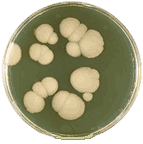Papers in the Biological Sciences
Date of this Version
2017
Document Type
Article
Citation
FEBS Letters 591 (2017) 1637–1640
doi: 10.1002/1873-3468.12636
Abstract
Candida albicans is a clinically important dimorphic fungus that exhibits either a budding yeast or a mycelial-hyphal or pseudohyphal growth, depending on environmental conditions. The yeast-to-mycelia morphologic transition, which is generally regarded as an important virulence determinant, depends on the inoculum size of liquid cultures. The yeast form is favored when cultures are inoculated at > 106 cells∙mL–1, whereas the mycelial form is favored at inoculum densities < 106∙mL–1. Farnesoic acid (FA) and farnesol (FOH) are two related sesquiterpene quorum- sensing molecules that, upon accumulation, prevent the yeast-to-mycelial conversion. Oh et al. showed that C. albicans strain ATCC 10231 excretes FA, while Hornby et al. showed that C. albicans A72 and SC5314 excrete FOH. Subsequent work indicated that 10231 was the only isolate of C. albicans that fails to produce detectable FOH. Moreover, when tested on C. albicans A72, FA had only 3.2% of the hyphal-inhibitory activity relative to FOH. These observations raised two questions: 1., Do FOH and FA block mycelial development via the same molecular mechanism; and 2., What is the biochemical or physiologic difference in strain 10231 that underlies excretion of FA and not FOH?
Do farnesol and farnesoic acid share a common mechanism of action?
An apparent paradox in the regulation of hyphal morphogenesis by CaPho81p
Why does C. albicans strain 10231 secrete farnesoic acid, while other C. albicans strains secrete farnesol?
Included in
Environmental Microbiology and Microbial Ecology Commons, Other Life Sciences Commons, Pathogenic Microbiology Commons


Comments
Copyright 2017 Federation of European Biochemical Societies